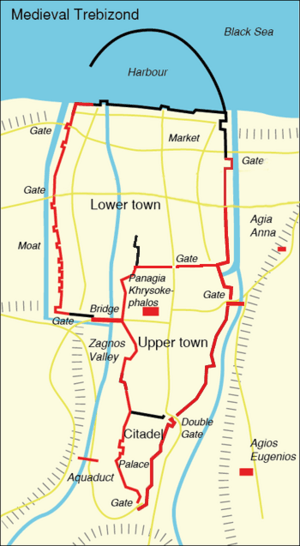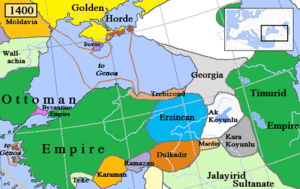Empire of Trebizond facts for kids
The Empire of Trebizond was a country that existed from the 13th to the 15th century. It was one of the states that formed after the Byzantine Empire became weaker. This empire was located in the northeastern part of what is now Turkey, along the Black Sea coast, and also included a small area in the southern Crimea.
Quick facts for kids
Empire of Trebizond
|
|||||||||||||
|---|---|---|---|---|---|---|---|---|---|---|---|---|---|
| 1204–1461 | |||||||||||||
|
Double-headed eagle flag as depicted in Western portolans
|
|||||||||||||

Map of the Empire of Trebizond shortly after the foundation of the Latin Empire in 1204, featuring the short-lived conquests in western Anatolia by David Komnenos (later reconquered by the Empire of Nicaea) and Sinope (later conquered by the Sultanate of Rum).
|
|||||||||||||
| Status |
|
||||||||||||
| Capital | Trebizond | ||||||||||||
| Common languages |
|
||||||||||||
| Religion | Greek Orthodoxy | ||||||||||||
| Government | Monarchy | ||||||||||||
| Notable emperors1 | |||||||||||||
|
• 1204–1222
|
Alexios I | ||||||||||||
|
• 1238–1263
|
Manuel I | ||||||||||||
|
• 1280–1297
|
John II | ||||||||||||
| Historical era | Late Middle Ages | ||||||||||||
|
• Establishment
|
1204 | ||||||||||||
|
• Fall of Constantinople to the Fourth Crusade
|
12 April 1204 | ||||||||||||
|
• Submission to the Mongol Empire
|
1243 | ||||||||||||
|
• Permanent loss of Sinope
|
1265 | ||||||||||||
|
• John II renounces Imperial claims
|
1282 | ||||||||||||
|
• Trapezuntine Civil Wars
|
1340–1349 | ||||||||||||
|
• Fall of Trebizond
|
15 August 1461 | ||||||||||||
|
|||||||||||||
|
1 the full title of the Trapezuntine emperors after 1282 was "the faithful Basileus and Autokrator of All the East, the Iberians and Perateia"
|
|||||||||||||
The Empire of Trebizond was started in 1204. This happened with help from Queen Tamar of Georgia. She supported Alexios I Komnenos and his brother David. They were grandsons of a former Byzantine Emperor. They took control of the city of Trebizond. This was just before Constantinople, the capital of the Byzantine Empire, was attacked by crusaders.
After Constantinople fell, three new states claimed to be the true Byzantine Empire. Trebizond was one of them. The others were the Empire of Nicaea and the Despotate of Epirus. The rulers of Trebizond called themselves "Roman emperors" for a while. But in 1282, Emperor John II of Trebizond gave up this claim. He changed his title to "Emperor and Autocrat of all the East, Iberia and Perateia."
The Empire of Trebizond lasted longer than the other Byzantine successor states. It survived until 1461. That year, the Ottoman Empire conquered it after a long siege. The last ruler, David of Trebizond, was captured. A smaller state, the Principality of Theodoro, which was connected to Trebizond, lasted a bit longer. It fell to the Ottomans in 1475.
Contents
How the Empire Began
The city of Trebizond had a long history of being somewhat independent. It was a good place for a city because it had natural harbors. It also had strong defenses and access to silver and copper mines. This made it an important Greek colony on the Black Sea coast.
Local rulers often had more power because the city was far from the main Roman capitals. Before the empire was founded, a local family called the Gabras controlled Trebizond. They even made their own coins. This showed they were acting like independent princes.
The Empire of Trebizond officially began in April 1204. Alexios Komnenos and his brother David took over Trebizond. They did this with soldiers from their relative, Queen Tamar of Georgia. They took advantage of the fact that the main Byzantine government was busy with the Fourth Crusade.
Some historians believe that the new state was under Georgia's control at first. Alexios and David were grandsons of the former Byzantine Emperor Andronikos I Komnenos. Their aunt, Queen Tamar, helped them return to Byzantine lands. She might have wanted to create a safe area for Georgia. Or she might have wanted them to take back the Byzantine throne.
After marching from Georgia, Alexios and David captured Trebizond. Alexios was then declared emperor at age 22. This moment is seen as the start of the Empire of Trebizond. Alexios ruled for 22 years.
Historians have found a special seal belonging to Alexios. It shows Saint George leading Alexios into Trebizond. This seal suggests that Trebizond was captured around April 23-25, 1204. This was before news of Constantinople's fall reached them. So, their first goal was likely to create their own state. But once Constantinople fell, they joined the race to reclaim the Byzantine Empire.
Geography and Borders
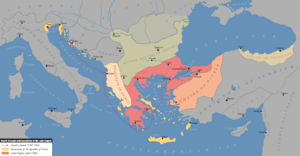
The Empire of Trebizond was a narrow strip of land. It stretched along the southern coast of the Black Sea. It also included the western part of the Pontic Mountains. For a time, it controlled parts of the southern Crimea. However, these areas were soon lost to Italian trading cities and local princes.
The main part of the empire was the Black Sea coast. This area was protected by the Pontic Alps mountains. These mountains helped keep out attacks from the Seljuk Turks and later the Turkoman groups. This made it easier for the emperors to defend their land.
The empire's territory included parts of modern-day Turkish provinces. These include Sinop, Samsun, Ordu, Giresun, Trabzon, Bayburt, Gümüşhane, Rize, and parts of Artvin.
In the 13th century, the first emperor's brother, David Komnenos, expanded the empire to the west. He took Sinope and other coastal areas. But this expansion did not last long. Most of these lands were lost by 1214. Sinope itself fell to the Seljuks that same year.
Important Periods in History
Early Years and Challenges
For most of the 13th century, Trebizond faced many conflicts. It fought against the Seljuk Sultanate and later the Ottoman Empire. It also had issues with Constantinople and Italian trading cities like Genoa. The empire survived by playing its rivals against each other. Its rulers also used marriages to make alliances. They married their daughters, who were known for their beauty, to rulers of neighboring Turkish states.
The empire also relied on trade for its wealth. Merchants from Genoa and Venice traded through Trebizond. This trade brought in money that helped the empire stay independent.
Manuel I (1238–1263), the second son of Alexios I, was a strong ruler. He kept the empire safe and was a skilled military leader. He even captured Sinope in 1254. Manuel was the first ruler to make silver coins for Trebizond.
When Hulagu Khan destroyed Baghdad in 1258, trade routes changed. The Silk Road moved north to the Black Sea. Trebizond became a very rich city because of its connection to Tabriz, a Mongol capital. Many Western travelers, like Marco Polo, passed through Trebizond on their journeys to Asia.
John II (1280–1297) had a difficult reign. But he made peace with the restored Byzantine Empire. This ended Trebizond's claim to rule Constantinople. His son, Alexios II (1297–1330), ruled for a long time. During his rule, Trebizond was very wealthy and known for its art.
Civil Wars and Recovery
After Alexios II died, Trebizond went through a tough time. There were many changes in rulers, and some were even killed. Two main groups fought for power. The empire became weak. The Turks took advantage of this. They attacked cities and even besieged Trebizond. The Black Death, a terrible plague, also spread through the empire.
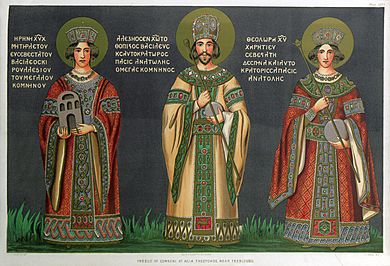
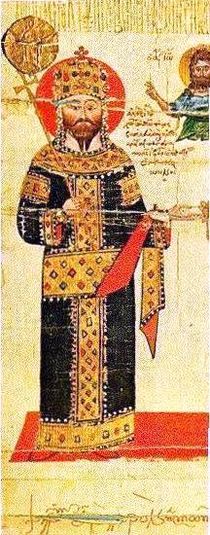
In 1349, Emperor Michael gave up his throne. His nephew, Alexios III, became the new emperor. Alexios III slowly brought peace back to the empire. Under his rule, Trebizond became an important trade center again. It was known for its wealth and beautiful art. Alexios III also continued the tradition of marrying princesses to neighboring Turkish rulers to build alliances.
The Final Years
By the late 1300s, the Ottoman Empire was growing stronger. This new Turkish power was a big threat to Trebizond. Manuel III (1390–1417) tried to make an alliance with Tamerlane, a powerful conqueror. But Tamerlane soon left the area, and his empire fell apart.
Manuel's son, Alexios IV (1417–1429), continued to use political marriages. He married two of his daughters to rulers of neighboring Muslim empires. His oldest daughter also married the Byzantine Emperor.
John IV (1429–1459), Alexios IV's son, knew that Trebizond might soon fall. The Ottoman Sultan Murad II tried to attack Trebizond by sea in 1442, but failed. Later, in 1456, an Ottoman governor attacked Trebizond. He took many prisoners and demanded a large payment.
John IV tried to prepare for the Ottoman attack by making alliances. He sent a representative to a church meeting in Italy. He also gave his daughter Theodora in marriage to Uzun Hasan, a powerful Turkish ruler. In return, Uzun Hasan promised to defend Trebizond. John also got promises of help from other Turkish rulers and from Georgia.
After John IV died in 1459, his brother David became emperor. David tried to get help from European countries. But the Ottoman Sultan Mehmed II heard about these plans. Mehmed was also angered when David demanded that he cancel the tribute payment.
Mehmed II decided to act in the summer of 1461. He gathered a large army and marched towards Trebizond. He first took Sinope, then moved to neutralize Uzun Hasan. With Trebizond isolated, Mehmed quickly attacked. The city was besieged for a month. Finally, David surrendered on August 15, 1461.
With the fall of Trebizond, the last independent part of the Byzantine Empire was gone.
Culture and Religion
Religious Life
Christianity was very important in the Empire of Trebizond. Records from the Vazelon Monastery show that many peasants had Christian first names. Their last names often came from Christian saints, jobs, or places.
The empire had three main church areas called dioceses. These were Trebizond, Cerasous, and Rizaion. All three continued to exist even after the Ottoman conquest in 1461. However, the dioceses of Cerasous and Rizaion were later closed. This happened as more people in those areas became Muslim.
See also
 In Spanish: Imperio de Trebisonda para niños
In Spanish: Imperio de Trebisonda para niños



